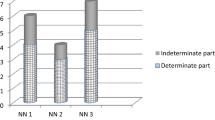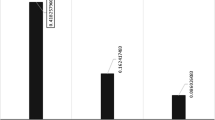Abstract
This paper presents the goal geometric programming method in neutrosophic environment. Neutrosophic set is one of the most useful tools to express uncertainty, impreciseness in a more general way compare to fuzzy set and intuitionistic fuzzy set. Thus, the proposed approach is described here as an extension of fuzzy goal geometric programming and intuitionistic fuzzy goal geometric programming. To demonstrate the methodology and applicability of the proposed approach, a multi-objective nonlinear reliability optimization model is taken here and it is evaluated comparing the result obtained by the proposed method with the solution obtained in intuitionistic fuzzy goal geometric programming technique at the end of this paper.


Similar content being viewed by others
References
Zadeh, L.A.: Fuzzy sets. Inf. Control 8, 338–353 (1965)
Atanassov, K.: Intuitionistic fuzzy sets. Fuzzy Sets Syst. 20, 87–96 (1986)
Zimmermann, H.J.: Fuzzy Set Theory—And Its Applications. Allied Publishers limited, Mumbai (1996)
Atanassov, K.: Intuitionistic Fuzzy Sets. Physica-Verlag, Heidelberg (1986)
Smarandache, F.: Neutrosophy, Neutrosophic Probability. Set and Logic. American Research Press, Rehoboth (1998)
Pal, B.B., Maitra, B.N., Maulik, U.: A goal programming procedure for multi-objective linear programming problem. Fuzzy Sets Syst 139, 395–405 (2003)
El-Wahed, W.F.A., Sang, S.M.: Interactive fuzzy goal programming for multi-objective transportation problems. Int. J. Manag. Sci. 34, 158–166 (2006)
Hwang, C.L., Lee, H.B.: Non-linear integer goal programming applied to optimal system reliability. IEEE Trans. Reliab. 33, 431–438 (2004)
Zangiabadi, M., Maleki, H.R.: Fuzzy goal programming for multi-objective transportation problem. J. Appl. Math. Comput. 24, 449–460 (2007)
Ghosh, P., Roy, T.K., Majumder, C.: Optimization of industrial wastewater treatment using intuitionistic fuzzy goal geometric programming problem. Fuzzy Inf. Eng. 8, 329–343 (2016)
Ghosh, P., Roy, T.K.: Intuitionistic fuzzy goal geometric programming problem. Notes Intuit. Fuzzy Sets 20(1), 63–78 (2014)
Ye, J.: Trapezoidal neutrosophic set and its application to multiple attribute decision-making. Neural Comput. Appl. 26(5), 1157–1166 (2015)
Das, P., Roy, T.K.: Multi-objective programming problem based on neutrosophic geometric programming technique. Neutrosophic Oper. Res. I, 131–142 (2016)
Roy, R., Das, P.: Neutrosophic goal programming applied to bank: three investment problem. NSS 12, 97–104 (2016)
Ye, J.: Multi-criteria decision making method using aggregation operators for simplified neutrosophic sets. J. Intell. Fuzzy Syst. (2013). https://doi.org/10.3233/IFS-130916
Ye, J.: Multi-criteria decision making method using the correlation coefficient under single-value neutrosophic environment. Int. J. Gen. Syst 42(4), 386–394 (2013)
Wang, H., Smarandache, F., Zhang, Y., Sunderraman, R.: Single valued neutrosophic sets. Multispace Multistruct. 4, 410–413 (2010)
Tillman, F.A., Hwng, C.L., Fan, L.T., Lai, K.C.: Optimal reliability of a complex system. IEEE Trans. Reliab. 19(3), 95–100 (1970)
Acknowledgements
The authors wish to acknowledge the University of Kalyani for financial support through the university research scholarship (URS) and DST-PURSE in the Department of Mathematics, University of Kalyani, Kalyani.
Author information
Authors and Affiliations
Corresponding author
Appendices
Appendix 1
1.1 Proof of Lemma 3.1
From the Eq. (3.5) we have
In the above-mentioned neutrosophic goal programming problem, we consider each objective functions \(f_{oi} \left( x \right)\) satisfying target achievement value \(b_{0i}\) and also from the relation,
Thus the relation (i) is true if \(\left( {\frac{1}{{d_{0i} }} - \frac{1}{{a_{0i} }}} \right) \ge 0\)
Hence from relation (iii), we have in neutrosophic goal geometric programming problem, acceptance tolerance \(a_{0i}\) should be greater than indeterminacy tolerance \(d_{0i}\).
Again from the relation \(\mu_{i} \left( {f_{oi} } \right) \ge \vartheta_{i} \left( {f_{oi} } \right)\) and \(\mu_{i} \left( {f_{oi} } \right) \ge \sigma_{i} \left( {f_{oi} } \right)\)
Adding the above inequalities (iv) and (v), we get
Now from (3.5) using the relation
Hence from \(\mu_{i} \left( {f_{oi} } \right) + \vartheta_{i} \left( {f_{oi} } \right) + \sigma_{i} \left( {f_{oi} } \right) \le 3\) using (vi) and (vii)
Thus from the above relation, it is clear that in neutrosophic goal geometric programming problem half of the rejection tolerance \(r_{0i}\) should be greater than the indeterminacy tolerance \(d_{0i}\).
Appendix 2
2.1 Proof of Theorem 3.1
If \(x^{*}\) be a Pareto optimal solution of the FGGPP (3.10) then there does not exist any x such that \(f_{oi} \left( x \right) \le f_{oi} \left( {x^{*} } \right)\) for all i = 1, 2,…, p. and \(f_{oi} \left( {x^{*} } \right) \ne f_{oi} \left( x \right)\) for at least one i.
Then we have for all \(x = \left( {x_{1} ,x_{2} , \ldots ,x_{m} } \right)\),
with strict inequality hold for at least one i.
Similarly from (A) we have \(\frac{{f_{oi} \left( x \right) - b_{0i} }}{{r_{0i} }} \le \frac{{f_{oi} \left( {x^{*} } \right) - b_{0i} }}{{r_{0i} }}\) which implies \(\vartheta_{i} \left( {f_{oi} \left( x \right)} \right) \le \vartheta_{i} \left( {f_{oi} \left( {x^{*} } \right)} \right)\)
or, \(\sigma_{i} \left( {f_{oi} \left( x \right)} \right) \ge \sigma_{i} \left( {f_{oi} \left( {x^{*} } \right)} \right)\). Hence from the definition of Pareto optimal solution to the NGGPP, we have \(x^{*}\) is the Pareto optimal solution of (3.1).
Conversely, let \(x^{*}\) is a Pareto optimal solution to NGGPP (3.1), then from the expression of membership function given in (3.2) we get
Again using (3.3) we have \(\frac{{f_{oi} \left( x \right) - b_{0i} }}{{d_{0i} }} \le \frac{{f_{oi} \left( {x^{*} } \right) - b_{0i} }}{{d_{0i} }}\) which implies \(f_{oi} \left( x \right) \le f_{oi} \left( {x^{*} } \right).\)
Similarly, using (3.4), \(1 - \frac{{f_{oi} \left( x \right) - b_{0i} }}{{d_{0i} }} \ge 1 - \frac{{f_{oi} \left( {x^{*} } \right) - b_{0i} }}{{d_{0i} }}\) gives \(f_{oi} \left( x \right) \le f_{oi} \left( {x^{*} } \right).\)
Thus we have \(f_{oi} \left( x \right) \le f_{oi} \left( {x^{*} } \right)\) with strict inequality hold for at least one i, \(i \in \left\{ {1,2, \ldots ,p} \right\}\) and which shows that \(x^{*}\) is a Pareto optimal solution of (3.10).
Rights and permissions
About this article
Cite this article
Kundu, T., Islam, S. Neutrosophic Goal Geometric Programming Problem and Its Application to Multi-objective Reliability Optimization Model. Int. J. Fuzzy Syst. 20, 1986–1994 (2018). https://doi.org/10.1007/s40815-018-0479-2
Received:
Revised:
Accepted:
Published:
Issue Date:
DOI: https://doi.org/10.1007/s40815-018-0479-2




